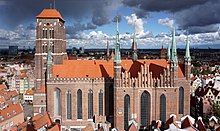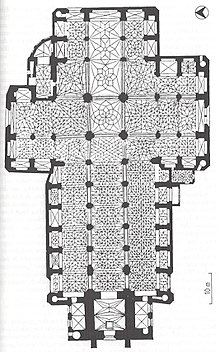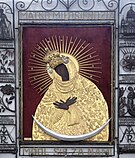Marienkirche (Danzig)
The Cathedral Basilica of the Assumption of the Blessed Virgin Mary (Polish: Bazylika konkatedralna Wniebowzięcia Najświętszej Maryi Panny , until 1945 St. Mary's Parish Church ) is the main parish church of the city of Gdansk in Poland . It was built from 1343 to 1502 in the Gothic style.
history
Construction period 1343–1502
On March 28, 1343, construction of a new hall church began on a previous Romanesque building. The builder was Heinrich Ungeradin . In 1466 a royal chapel was built for the Polish king. In 1502 the construction of the Marienkirche was finished after 159 years.
Evangelical Church 1525–1945
In 1525 Michael Meurer briefly became the first Lutheran pastor, and from 1526 masses were held again according to the Catholic rite, although Pankratius Klemme tried to give evangelical sermons. From 1557 Protestant services could be officially held.
On May 4th 1613 the S. Jakob tower was struck by lightning and burned down to the brickwork. In 1618 the tower was rebuilt with a copper roof as before. (The inscription on the tower indicates this event.)
Until 1945 the Marienkirche was the second largest Evangelical Lutheran place of worship in the world (only the Ulm Minster is slightly larger).
During the Second World War, the Marienkirche was badly damaged in March 1945 when the city was conquered by the Red Army ; forty percent of the art treasures were destroyed. The wooden roof structure burned out, 14 of the large arches collapsed and the glass windows were destroyed.
Catholic Church since 1955
The reconstruction of the church building began in 1946, in August 1947 the roof, a reinforced concrete structure, was completed. Because of the expulsion of the German Danzigers , mainly Protestants , and the influx of Poles , mostly Catholics , it has been a Catholic church since the church consecration on November 17, 1955. In 1965 the church was elevated to a minor basilica , and since 1986 it has been co- cathedral of the Oliva diocese, which was elevated to the archbishopric of Gdansk in 1992 .
architecture
The Marienkirche in Gdańsk is one of the largest hall churches in the world and one of the three largest brick churches north of the Alps.
Compared to most other works of brick Gothic in the area of the southern Baltic Sea coast, it has a few special features:
The nave, transept and choir have no buttresses , but the sideshift of the vaults is intercepted by rows of chapels along the outer walls, so the partition walls between the chapels serve as buttresses. Only a few churches in northern Germany and the former Order Land have that, but far away the Munich Frauenkirche and the single-nave cathedral of Albi , despite its size , the most famous Gothic brick building in southern France . The rectangular end of the choir differs between the Marienkirche in Gdańsk and the Frauenkirche in Lübeck , but not from the Königsberg Cathedral or the Gothic churches in Bremen.
Bertinuskerk in Poperinge , West Flanders , Belgium
The roofing shows a complicated system of roof ridges, each consisting of three parallel longitudinal roofs over the nave and choir, as well as three or two parallel roofs across the transept arms. Most of the large churches in Gdansk have such parallel roofs, albeit without transept roofs, and in the vicinity of the Vistula Delta also the Nikolaikirche in Elbląg , where, during the reconstruction after World War II, attempts were made to come close to the state before the fire of 1777. This roof arrangement is extremely rare in northern Germany, whereas in the Netherlands and Flanders it is the most common in hall churches.
The tower has massive Gothic buttresses, while most of the church towers on the south coast of the Baltic Sea, following the Lübeck Marientürme, have Gothic windows and panels , but the simple rectangular cross-section of Romanesque church towers. Brick towers with Gothic buttresses also have the cathedrals of Gniezno , Wroclaw and Roskilde . The Danzig Marienturm is particularly similar to the Belfry of Dunkirk , one of around fifty brick Gothic buildings in French Flanders .
Furnishing
The interior of the Marienkirche is one of the richest in the Baltic Sea area today , with numerous retables , sculptures , wall and panel paintings.
Gravesites
In the church there are numerous grave slabs of citizens and clergy. These include those of the baroque poet Martin Opitz von Boberfeld and the former Sejmmarschall Maciej Płażyński . A memorial next to his sarcophagus commemorates the plane crash near Smolensk on April 10, 2010.
On January 19, 2019, the mayor Paweł Adamowicz, who was murdered on January 14, 2019, was buried in the south transept of the cathedral.
Inventory in other locations
In the National Museum (Gdansk) are among others
- The Last Judgment (Hans Memling) , triptych 1467–1471
- Parts of the Danzig Parament Treasure , a collection of liturgical vestments from St. Mary's Church, by far the richest treasure of its kind. The majority is now in Lübeck's St. Annen Museum Quarter .
Bells
In the 82 m high tower hang two church bells , which were cast in 1970 by the Felczyński foundry in Przemyśl . The larger bell is called Gratia Dei , weighs 7,850 kg and sounds in the tone f sharp 0 . Ave Maria is the name of the smaller bell that weighs 2,600 kg (tone c sharp 1 ).
From the pre-war bell, the largest bell of which was the 6,800 kg predecessor of the Gratia Dei , cast in 1453 , two bells have been preserved and are rung in other places: The Osanna (b 0 ) from 1632 (cast: Ludwig Wichtendal the Younger ) in St. Andreas zu Hildesheim , the Dominicalis (d 1 ) from 1719 - under the name Osanna - in the Marienkirche (Lübeck) .
Jewelry shapes
As is to be expected in the brick Gothic, the building has ornaments made of shaped stone in several places , for example numerous blind gables between the pilasters of the gable. The rectangular frieze around the west portal and the window above is a masterpiece of molded stone art.
But there are also jewelery made of stone; all side portals, three on the south side, two on the north side and one on the east side, are made of stone carvings made of natural stone. Around the middle window of both gable sides of the transept and around the westernmost window of the north aisle there are narrow rectangular cornices made of ashlar. The tracery of the windows, now mostly made of metal, was at least partly made of ashlar before the Second World War.
Church music
Events
organ
In 1509 the parish had organ builder Blasius Lehmann build a large organ with 1926 pipes for 3800 marks. In 1510 a smaller organ was installed above the All Saints Chapel, which was mainly used during the weekly church services and was nicknamed the cursed organ . As early as 1523 it had to be repaired by Blasius himself and was out of service from 1546, but was not removed until 1777.
After the siege of Danzig in 1520 by an army of the order under the direction of Count Wilhelm von Eisenberg and Wolf von Schönberg, the two existing organ works were repaired and two more were built, in 1522 over the sacristy and in 1524 over the Reinhold chapel. Danzig was able to afford the opulent building of ever new organs because of its wealthy citizens; They were also financed from the proceeds of two letters of indulgence from Pope Leo X.
The original large organ by the organ builder Julius Anthoni dates back to 1586 in its oldest parts and was completely destroyed in 1945. As a replacement, the much smaller prospectus of the Johanniskirchen organ from 1629, which had been preserved, was installed in 1985 and equipped with a reconstruction of the organ, financed by German donations, by the Hillebrand brothers from Altwarmbüchen . The 46 registers are divided into three manuals and pedal , the action is mechanical.
Dimensions

| overall length | 105.5 m |
| Greatest width (the length of the transept) |
66.0 m |
| Width of the nave | 41 m |
| Width of the presbytery | 35 m |
| Largest interior height | 29.0 m |
| Height of the zygomatic arches | 27 m |
| Roof area | 8,000 m² |
| Usable area | 5,000 m² |
| Total volume | 185,000 to 190,000 m³ |
| Volume without roofs |
155,000 m³ |
| window | 37 |
| Largest window | 127 m² |
| Height of the bell tower | 82 m |
| Steps to the tower | 409 |
| Laying of the foundation stone | March 25, 1343 |
| completion | 1502 |
Clergy
Catholic priests until 1525
The Marienkirche had a Catholic pastor until 1525, who also received the income. This employed assistant priests (vicars), who usually held the masses for him.
- Mauritius Ferber (1471–1537), pastor 1516–1522
- Alexander Svenichen (–1529), 1523–25 last Catholic pastor until 1945
Evangelical preachers 1525–1945
In 1525, Michael Meurer, a Lutheran pastor, was hired for the first time in Polish Prussia. The pastors had to celebrate the Catholic mass again from 1526, but were allowed to preach Protestant. From 1557, divine service could be celebrated according to the evangelical rite with the Lord's Supper in both forms.
There was usually a pastor primarius (first pastor) and a deacon (second preacher). Some senior pastors also became senior ministers (first pastors in the city). Until 1617 there were some Reformed preachers in the Marienkirche ( Martinus Remus , Thomas Fabricius ).
- Michael Meurer (~ 1475–1537), 1525 to 1526 first Lutheran pastor
- Pankratius Klemme , pastor 1526–48, preached Lutheran but had to observe the Catholic ceremonies
- Johann Kittel , 1566–1586 / 90 senior pastor in Danzig (not only employed for St. Mary's Church)
- Peter Praetorius , 1575–86 / 88
- Martinus Remus , 1595–1617 ?, reformed
- Thomas Fabricius , 1597–1617, last Reformed preacher in St. Mary's Church
- Hermann Rathmann , 1617–1626, second preacher
- Johannes Corvinus , 1618–1643, first pastor, senior minister
- Daniel Dilger , 1628-1643
- Nathanael Dilger (1604–1679), 1638–1679, son of Daniel Dilger, Senior of the Ministry of Spirituality
- Karl Joachim Sibeth (1692–1748), 1737–1748, Senior of the Ministry of Spirituality
- August Müller (1807–1872), Archdeacon
- Artur Brausewetter (1864–1946),? –1934, writer
- Gerhard M. Gülzow (1904–1980), 1934–?
literature
- Willi Drost : The Marienkirche in Gdansk and its art treasures (= architectural and art monuments of the German East. Series A, Volume 4), Kohlhammer Verlag, Stuttgart 1963.
- Karl Gruber , Erich Keyser : The Marienkirche in Danzig. In: The architectural monuments of the free city of Gdansk. Volume 1. Deutscher Kunstverlag, Berlin 1929.
- Karl Gruber: The shape of Gdańsk's Marienkirche before it was converted into a hall church. In: Journal for East Research. Volume 10, 1961.
- Theodor Hirsch : The upper parish church of St. Marien in Danzig: in its monuments and in its relationship to the church life of Danzig in general. Anhuth, Danzig 1843. ( digitized version ) the most detailed historical representation
- Rudolf Bergau : The old Marienkirche in Danzig . In: Year books for art history (A. von Zahn, ed.). Volume 1. Leipzig 1868, pp. 123-137.
- A. Hinz: The Treasury of St. Mary's Church in Danzig ( review )
- Joseph Karabacek: The liturgical vestments with Arabic inscriptions from the Marienkirche in Danzig . Vienna 1870 ( online ).
- Gerhard Weilandt: Transfer Culture - Danzig in the Late Middle Ages. In: Wolfgang Augustyn, Ulrich Söding (Hrsg.): Original - Copy - Quote. Works of art from the Middle Ages and the Early Modern Age: Ways of Appropriation - Forms of Tradition (= publications by the Central Institute for Art History in Munich. 26), Passau 2010, pp. 73-100.
- Wolfgang Deurer : Danzig. Documentation of 52 historical churches. Wesel 1996, ISBN 3-00-000978-7 , pp. 463-464.
Web links
- Triptych The Last Judgment
- History of the organs of St. Marien zu Danzig (German, Polish, English)
- St. Mary's Church website (Polish)
- Literature about the Marienkirche LitDok East Central Europe , Herder Institute Marburg
Remarks
-
↑ For comparison:
- Munich Frauenkirche : also 185,000 to 190,000 m³ and also a Gothic hall church made of brick
- Ulm Minster : 190,000 m³, walled nave 140,000 m³ to 160,000 m³ (largest Protestant church, basilica, built to a large extent from brick, but optically receding behind the lavishly designed sandstone parts)
- San Petronio in Bologna : around 258,000 m³ (probably the largest Gothic brick church)
- ↑ Müller was first a grammar school teacher, then pastor in Bartenstein (1837). In 1830/31 he was the first senior in the Masovia Corps .
Individual evidence
- ↑ Deurer 1996, p. 463.
- ↑ a b c Theodor HIRSCH: The upper parish church of St. Marien in Danzig in its monuments and in its relationship to the church life of Danzig in general, depicted by Dr T. Hirsch. First part . Anhut, Danzig 1843, p. 223 f., p. 359 .
- ↑ Spiegel Online from January 19, 2019
- ↑ Max Töppen, Theodor Hirsch, Ernst Strehlke: The historical sources of the Prussian prehistoric times up to the decline of the order . tape 5 . European History Publishing House , 2015, ISBN 978-3-7340-0436-0 , pp. 459 .
- ^ Karl Friedrich Friccius: History of the fortifications and sieges of Danzig: With special consideration for the East Prussian Landwehr, which stood in front of Danzig in the years 1813–1814 . Veit, Berlin 1854, p. 9 .
- ↑ Information about the organ
- ^ Heinz Lingenberg : Oliva - 800 years. Outline of the story . Publishing house UNSER DANZIG. Lübeck 1986, ISBN 3-926482-00-1 , pp. 354-358.
- ↑ Calculation on built.eu
- ↑ structurae.de
- ↑ Ephraim Praetorius : Danzig teachers memory . Danzig, Leipzig 1760 pp. 1–3 lists the evangelical preachers of the Marienkirche (also of other Danzig churches)
Coordinates: 54 ° 21 ′ 0 ″ N , 18 ° 39 ′ 12 ″ E












